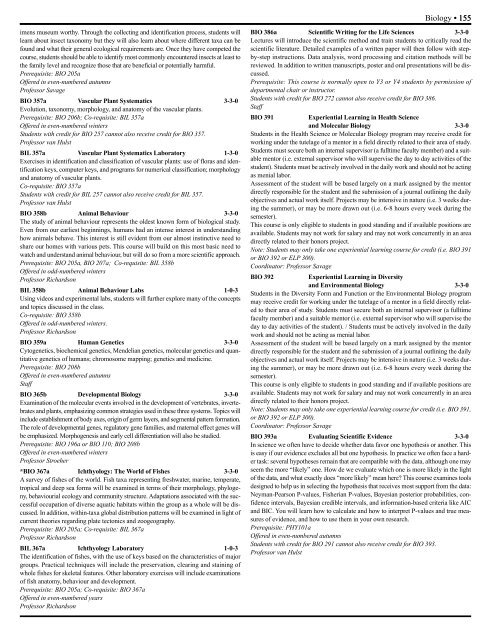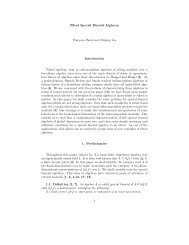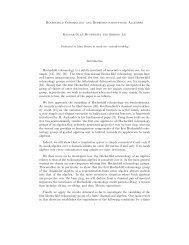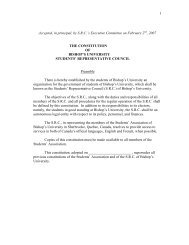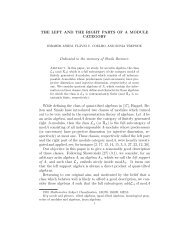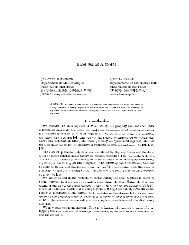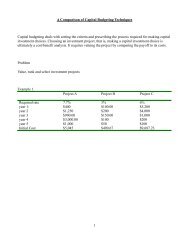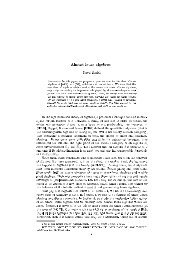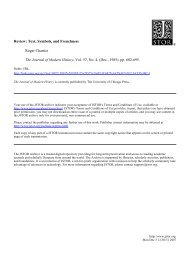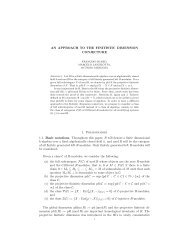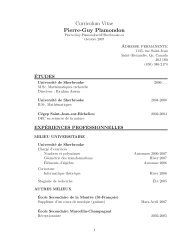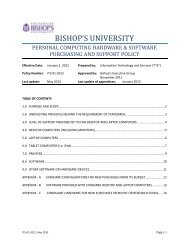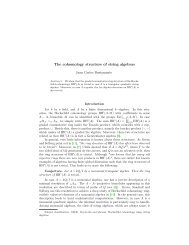Biological Sciences - Bishop's University
Biological Sciences - Bishop's University
Biological Sciences - Bishop's University
You also want an ePaper? Increase the reach of your titles
YUMPU automatically turns print PDFs into web optimized ePapers that Google loves.
Biology • 155<br />
imens museum worthy. Through the collecting and identification process, students will<br />
learn about insect taxonomy but they will also learn about where different taxa can be<br />
found and what their general ecological requirements are. Once they have competed the<br />
course, students should be able to identify most commonly encountered insects at least to<br />
the family level and recognize those that are beneficial or potentially harmful.<br />
Prerequisite: BIO 205a<br />
Offered in even-numbered autumns<br />
Professor Savage<br />
BIO 357a Vascular Plant Systematics 3-3-0<br />
Evolution, taxonomy, morphology, and anatomy of the vascular plants.<br />
Prerequisite: BIO 206b; Co-requisite: BIL 357a<br />
Offered in even-numbered winters<br />
Students with credit for BIO 257 cannot also receive credit for BIO 357.<br />
Professor van Hulst<br />
BIL 357a Vascular Plant Systematics Laboratory 1-3-0<br />
Exercises in identification and classification of vascular plants: use of floras and identification<br />
keys, computer keys, and programs for numerical classification; morphology<br />
and anatomy of vascular plants.<br />
Co-requisite: BIO 357a<br />
Students with credit for BIL 257 cannot also receive credit for BIL 357.<br />
Professor van Hulst<br />
BIO 358b Animal Behaviour 3-3-0<br />
The study of animal behaviour represents the oldest known form of biological study.<br />
Even from our earliest beginnings, humans had an intense interest in understanding<br />
how animals behave. This interest is still evident from our almost instinctive need to<br />
share our homes with various pets. This course will build on this most basic need to<br />
watch and understand animal behaviour, but will do so from a more scientific approach.<br />
Prerequisite: BIO 205a, BIO 207a; Co-requisite: BIL 358b<br />
Offered in odd-numbered winters<br />
Professor Richardson<br />
BIL 358b Animal Behaviour Labs 1-0-3<br />
Using videos and experimental labs, students will further explore many of the concepts<br />
and topics discussed in the class.<br />
Co-requisite: BIO 358b<br />
Offered in odd-numbered winters.<br />
Professor Richardson<br />
BIO 359a Human Genetics 3-3-0<br />
Cytogenetics, biochemical genetics, Mendelian genetics, molecular genetics and quantitative<br />
genetics of humans; chromosome mapping; genetics and medicine.<br />
Prerequisite: BIO 208b<br />
Offered in even-numbered autumns<br />
Staff<br />
BIO 365b Developmental Biology 3-3-0<br />
Examination of the molecular events involved in the development of vertebrates, invertebrates<br />
and plants, emphasizing common strategies used in these three systems. Topics will<br />
include establishment of body axes, origin of germ layers, and segmental pattern formation.<br />
The role of developmental genes, regulatory gene families, and maternal effect genes will<br />
be emphasized. Morphogenesis and early cell differentiation will also be studied.<br />
Prerequisite: BIO 196a or BIO 110; BIO 208b<br />
Offered in even-numbered winters<br />
Professor Stroeher<br />
*BIO 367a Ichthyology: The World of Fishes 3-3-0<br />
A survey of fishes of the world. Fish taxa representing freshwater, marine, temperate,<br />
tropical and deep sea forms will be examined in terms of their morphology, phylogeny,<br />
behaviourial ecology and community structure. Adaptations associated with the successful<br />
occupation of diverse aquatic habitats within the group as a whole will be discussed.<br />
In addition, within-taxa global distribution patterns will be examined in light of<br />
current theories regarding plate tectonics and zoogeography.<br />
Prerequisite: BIO 205a; Co-requisite: BIL 367a<br />
Professor Richardson<br />
BIL 367a Ichthyology Laboratory 1-0-3<br />
The identification of fishes, with the use of keys based on the characteristics of major<br />
groups. Practical techniques will include the preservation, clearing and staining of<br />
whole fishes for skeletal features. Other laboratory exercises will include examinations<br />
of fish anatomy, behaviour and development.<br />
Prerequisite: BIO 205a; Co-requisite: BIO 367a<br />
Offered in even-numbered years<br />
Professor Richardson<br />
BIO 386a Scientific Writing for the Life <strong>Sciences</strong> 3-3-0<br />
Lectures will introduce the scientific method and train students to critically read the<br />
scientific literature. Detailed examples of a written paper will then follow with stepby-step<br />
instructions. Data analysis, word processing and citation methods will be<br />
reviewed. In addition to written manuscripts, poster and oral presentations will be discussed.<br />
Prerequisite: This course is normally open to Y3 or Y4 students by permission of<br />
departmental chair or instructor.<br />
Students with credit for BIO 272 cannot also receive credit for BIO 386.<br />
Staff<br />
BIO 391<br />
Experiential Learning in Health Science<br />
and Molecular Biology 3-3-0<br />
Students in the Health Science or Molecular Biology program may receive credit for<br />
working under the tutelage of a mentor in a field directly related to their area of study.<br />
Students must secure both an internal supervisor (a fulltime faculty member) and a suitable<br />
mentor (i.e. external supervisor who will supervise the day to day activities of the<br />
student). Students must be actively involved in the daily work and should not be acting<br />
as menial labor.<br />
Assessment of the student will be based largely on a mark assigned by the mentor<br />
directly responsible for the student and the submission of a journal outlining the daily<br />
objectives and actual work itself. Projects may be intensive in nature (i.e. 3 weeks during<br />
the summer), or may be more drawn out (i.e. 6-8 hours every week during the<br />
semester).<br />
This course is only eligible to students in good standing and if available positions are<br />
available. Students may not work for salary and may not work concurrently in an area<br />
directly related to their honors project.<br />
Note: Students may only take one experiential learning course for credit (i.e. BIO 391<br />
or BIO 392 or ELP 300).<br />
Coordinator: Professor Savage<br />
BIO 392<br />
Experiential Learning in Diversity<br />
and Environmental Biology 3-3-0<br />
Students in the Diversity Form and Function or the Environmental Biology program<br />
may receive credit for working under the tutelage of a mentor in a field directly related<br />
to their area of study. Students must secure both an internal supervisor (a fulltime<br />
faculty member) and a suitable mentor (i.e. external supervisor who will supervise the<br />
day to day activities of the student). / Students must be actively involved in the daily<br />
work and should not be acting as menial labor.<br />
Assessment of the student will be based largely on a mark assigned by the mentor<br />
directly responsible for the student and the submission of a journal outlining the daily<br />
objectives and actual work itself. Projects may be intensive in nature (i.e. 3 weeks during<br />
the summer), or may be more drawn out (i.e. 6-8 hours every week during the<br />
semester).<br />
This course is only eligible to students in good standing and if available positions are<br />
available. Students may not work for salary and may not work concurrently in an area<br />
directly related to their honors project.<br />
Note: Students may only take one experiential learning course for credit (i.e. BIO 391,<br />
or BIO 392 or ELP 300).<br />
Coordinator: Professor Savage<br />
BIO 393a Evaluating Scientific Evidence 3-3-0<br />
In science we often have to decide whether data favor one hypothesis or another. This<br />
is easy if our evidence excludes all but one hypothesis. In practice we often face a harder<br />
task: several hypotheses remain that are compatible with the data, although one may<br />
seem the more “likely” one. How de we evaluate which one is more likely in the light<br />
of the data, and what exactly does “more likely” mean here? This course examines tools<br />
designed to help us in selecting the hypothesis that receives most support from the data:<br />
Neyman-Pearson P-values, Fisherian P-values, Bayesian posterior probabilities, confidence<br />
intervals, Bayesian credible intervals, and information-based criteria like AIC<br />
and BIC. You will learn how to calculate and how to interpret P-values and true measures<br />
of evidence, and how to use them in your own research.<br />
Prerequisite: PHY101a<br />
Offered in even-numbered autumns<br />
Students with credit for BIO 291 cannot also receive credit for BIO 393.<br />
Professor van Hulst


